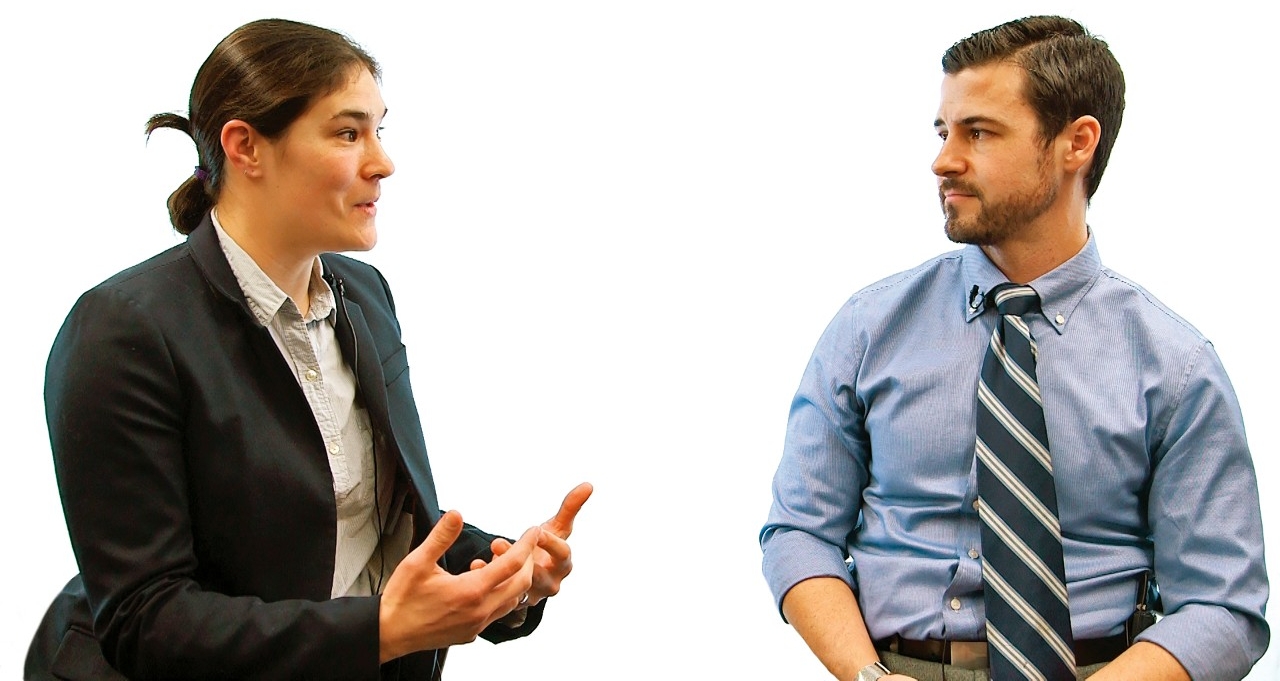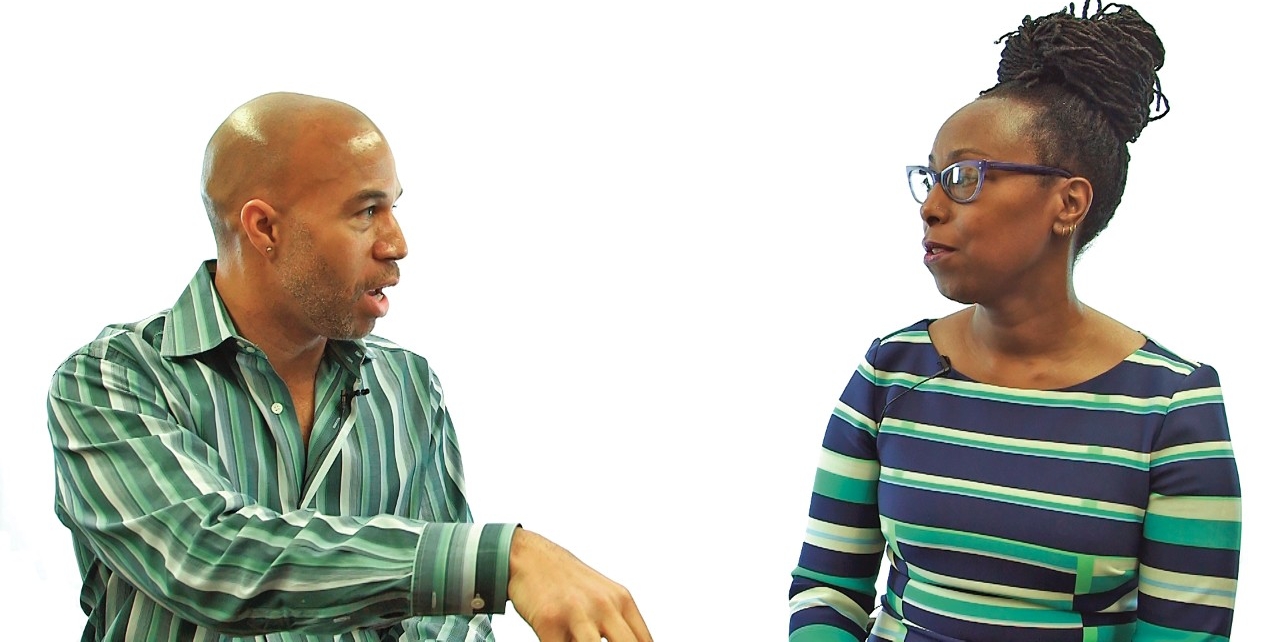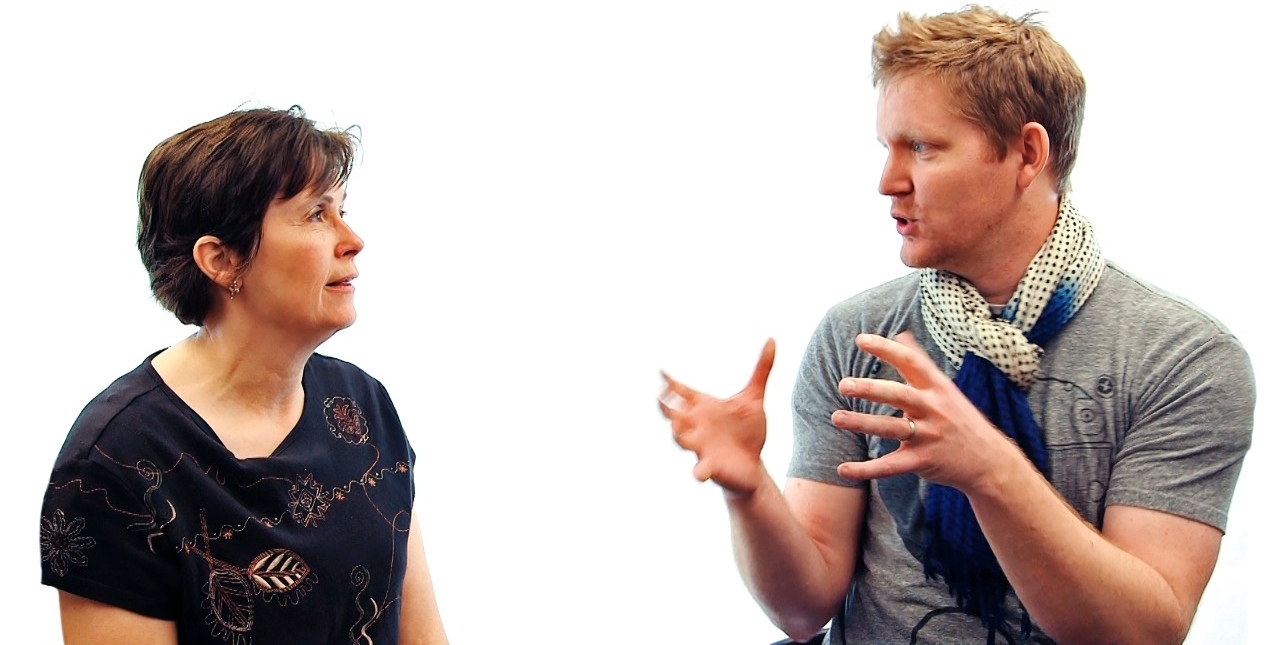Several new, collaboratively created pilot courses join this year's undergraduate curriculum as part of BC's three-year core renewal initiative. Faculty members discuss the process through which they conceived and developed their courses, and what they hope to achieve.

COURSE: A Perfect Moral Storm: The Science and Ethics of Climate Change
CATEGORY: Complex Problems
FACULTY: David Storey (Philosophy) and Corinne Wong (Earth and Environmental Sciences)
•Hatching the idea
WONG: Earth and Environmental Science is fundamentally an interdisciplinary discipline, as the questions we address require an understanding of the many different aspects of the earth – earth's interior, climate and atmosphere, rivers, oceans, and ice caps, terrestrial and aquatic biospheres – and have critical implications for the health and prosperity of human societies.
Climate change, in particular, is an issue that requires a fundamental understanding of the natural system to be in the best position to evaluate the consequences of future actions (or inaction), but determining what actions can and should be made given the economic and socio-political realities surrounding us requires expertise from many different disciplines. Teaming up with David to present the objective side while having students grapple with the subjective side of climate change only seemed natural.
STOREY: The challenge with exploring the ethics of climate change – and pretty much any environmental problem – is that you can't do so without delving into science, economics, policy, and a host of other disciplines. But if you just study the science, or the economics, or the policy, that doesn't tell you how individuals or governments ought to act or craft policy, or what the norms are that govern, or ought to govern, global agreements and treaties. No specialist can have an expertise in all of those disciplines, so it's a subject that naturally lends itself to study in an interdisciplinary context.
I also thought that studying the issue from the perspective of philosophical ethics made a lot of sense; ethics is sometimes sidelined in both political and academic discussions about climate change, or discussed in a superficial manner, but it's really at the heart the issue and actually quite complex. When I heard about the Complex Problems courses in the new core, I knew immediately what I wanted to do. Coupled with Pope Francis' recent encyclical on the environment, this made me realize it was the perfect time for a course like this, and for a course like this at BC in particular. That's when I reached out to the Environmental Studies program and found Corinne.
•How the course came together
WONG: To create a truly integrated interdisciplinary experience, we made a list of essential relevant topics from our respective disciplines and than identified topics to which both disciplines naturally speak to from vastly different perspectives. For example, future generations: While philosophical and ethical arguments about the consequences of future generations are considered on decadal to centennial time scales, earth scientists tend to think about processes carried out millennia, or even tens or hundreds of millennia.
STOREY: This was the "mind-meld." It was a totally new experience for me as a teacher, creating a syllabus with a faculty member not only from a different discipline, but a very different discipline. We met every week last semester, locked ourselves in a room, and patiently hammered out the syllabus. One of the things we decided early on was to weave together our different disciplinary perspectives in the syllabus. So rather than, say, four weeks of climate science, and then four weeks of ethical theory, we would braid them together more seamlessly. This ideally encourages students to be frequently flipping their perspective around, so that they can develop a sort of disciplinary dexterity, rather than "Here's what science says" or "Here's what philosophy says." This required us to familiarize ourselves with the methods and topics of each other’s respective disciplines to some extent, but I expect we will also learn a lot from each other as the course unfolds.
•Connecting to BC’s Jesuit, Catholic mission
WONG: This course is designed to help students objectively evaluate a complicated, politically charged challenge that their generation will be forced to face, and then have them reflect on the subjective: What could and should their role be in addressing the issue? The goal is to generate a populace that is informed of the challenges that our society faces and inspired to be leaders in working toward solutions.
STOREY: For one thing, I think our course dovetails with a sea change taking place in the Catholic world: the increased recognition of how social and environmental justice are intertwined spurred, in large part, by Laudato Si’ (which the students will be reading in their fall pre-requisite philosophy course). The environment is an issue young people generally care deeply about, and hopefully our course will give them some tools to help them deepen and direct that care intelligently and compassionately.
To help inspire students, we decided early on to swing for the fences in aiming to land high-quality guest speakers, including two former members of the Obama administration (an economist and an ethicist) and a former EPA scientist, for students to hear first-hand how professionals apply their disciplinary knowledge. We also decided to organize panel discussions around, for instance, "climate careers," to provide students with models (including BC alumni) for how they might operationalize what they are learning if they are pulled that direction.

COURSES: Narrating Black Intimacies; Black Intimacy and Intersectionality in the U.S.
CATEGORY: Enduring Questions
FACULTY: Shawn McGuffey (Sociology); Rhonda Frederick (English)
•Hatching the idea
Our paths crossed at many University, departmental/programmatic, and student-organized events. These more-or-less formal meetings became more regular because we are core faculty members in BC's African and African Diaspora Studies Program. As AADS faculty members, we are very aware of the other’s research areas, so we knew that we shared an interest in race. When the opportunity to teach a core pilot course came up, we found that we both were similarly interested in issues of intimacy, closeness and proximity.
•How the course came together
FREDERICK: From a literary perspective, I approached the idea of intimacy from the perspective of affective truths. Shawn was interested in how creative narratives represented sociological truths in ways that are compelling to students. I am interested in how sociology offers documentable "evidence" for themes that recur in the narratives I read and teach. It became clear that we both believe that truth/truths comes in different forms and that there are multiple ways of rendering and portraying them. Our classes will explore these possibilities.
One of the novels on my syllabus is Corregidora by Gayl Jones. It is compelling example of forced intimacies between a white slaveholder and a family of enslaved black women, but it is also set in Shawn's hometown of Lexington, Ky. He found another novel, A Mercy by Toni Morrison, a stunning account of class, race, and migrations.
•Connecting to BC’s Jesuit, Catholic mission
McGUFFEY: So here we are, looking forward to teaching two courses that reveal powerful, nuanced, unavoidable connections between and among blacks and whites that sociological studies and creative narratives present. We wanted each class to work with the same themes, and finding themes that made sense in our respective disciplines was hard. Ultimately, we broadened our themes ("Gray," "White," "Black," "Back to Gray") and worked out how each discipline and our primary readings specified the given theme. After that, everything was smooth sailing. We can think of no better way to manifest the idea of students' academic, intellectual and personal formations than to explore intra-racial and inter-racial intimate connections – forced, effaced, but often generative and vital.

COURSE: Can Creativity Save the World?
CATEGORY: Complex Problems
FACULTY: Crystal Tiala (Theatre) and Spencer Harrison (Carroll School of Management, Management and Organization)
•Hatching the idea
HARRISON: I have wanted to teach a class on creativity for a long time. It's what I research and it's a way of engaging with the world that I love. So the idea of teaching an entire class on the topic has been something rattling around in my head, waiting for an opportunity, for probably a decade or so. I really support the new vision for the core. I love BC's focus on liberal arts and developing the "whole person" but I was concerned that I didn't see insights from other disciplines emerging in conversations in my business class. I think the new core provides an environment that helps students see ideas as interchangeable building blocks rather than siloed disciplines.
TIALA: I have actively worked at teaching how to be a creative person and apply creativity to problem-solving. About eight years ago, I began working with student volunteers to see how the arts could help the world in socially responsible ways. I helped initiate students to take the arts to local schools and work with children, and brought in creative people who work in art and social justice as speakers or to do workshops. Currently my focus is facilitating the Prison Arts Outreach program. Each year about 20 great student volunteers go to the two women's prisons in Framingham on a regular basis and create art of all kinds with them to help empower and bring some humanity back to their lives. It is the perfect example of the power of art as a means to connect with people who need it the most.
•How the course came together
HARRISON: We actually used the same creative process we are teaching the students – the same sequence of steps – to generate the design for this course. We felt like if we were going to endorse a method then it had to be a method we had used ourselves. I find myself learning a lot. I think we've had to be more flexible in the moment as professors, more experimental, and more willing to shift things based on what one of us is doing and how the class is responding. It's made the teaching more dynamic but I think it also requires more from the students because the course is not as linear as other courses are.
I think what's been odd is that neither one of us has had to stray too far from our discipline. Part of that is the nature of our topic. Creativity, as a practice, requires drawing from diverse pools of knowledge. So it doesn't feel odd to pull ideas from different bodies of knowledge. I think what is possibly most strange is how much overlap there is.
TIALA: I have always been a person to try new things and take risks. The status quo never appealed to me. I am restless with an intense desire to learn and try new things. Spencer is teaching me quite a bit. It is both a lesson in humility and great opportunity to learn how to do things more effectively. I do actively try to adapt what I know and how I teach to fit this business model. However, I don't find it to be that much of a stretch. Innovative business practices are discovered by researching how creative people work. So it does not feel foreign to me at all. The biggest difference is that we speak two different languages. Once I translate what Spencer is saying, I find the process very familiar. I am not accustomed to teaching large classes either. My classes in the past have been more like studio art classes so it is a huge learning curve for me to figure out how to translate my past teaching methods to a large class.
•Connecting to BC’s Jesuit, Catholic mission
TIALA: I have already sought out how the arts can become socially responsible and the many ways that it might happen. This class focuses on creating performances and products that address social issues. I see our class as providing the creative building blocks to solve any problems students may encounter as they go forward. Theater really helps build confidence, teamwork, empathy, and observation skills. Similarly, innovative teams learn how to work well together and innovate exciting new ideas.
The University Core Renewal website includes detailed descriptions of all the pilot courses as well as short videos in which faculty members discuss the classes.
—News & Public Affairs



